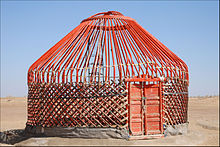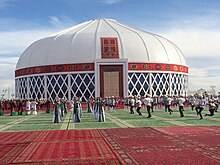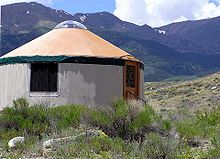Yurt
A yurt (from the Turkic languages) or ger (Mongolian) is a portable, round tent covered and insulated with skins or felt and traditionally used as a dwelling by several distinct nomadic groups in the steppes and mountains of Inner Asia.
[1] The structure consists of a flexible angled assembly or latticework of wood or bamboo for walls, a door frame, ribs (poles, rafters), and a wheel (crown, compression ring) possibly steam-bent as a roof.
The top of the wall of self-supporting yurts is prevented from spreading by means of a tension band which opposes the force of the roof ribs.
Nomadic farming with yurts as housing has been the primary life style in Central Asia, particularly Mongolia, for thousands of years.
He described yurt-like tents as the dwelling place of the Scythians, a horse riding-nomadic nation who lived in the northern Black Sea and Central Asian region from around 600 BC to AD 300.
They provide a large amount of insulation and protection from the outside cold of winters, and they are easily changed to keep the yurts cool for summertime.
Symbols representing strength are, for instance, the temdeg or khas (swastika), the four powerful beasts (lion, tiger, garuda – a kind of avian, and dragon), as well as stylized representations of the four elements (fire, water, earth, and air), considered to be the fundamental, unchanging elements of the cosmos.
[9] The shangyrak or wooden crown of the yurt (Mongolian: тооно, [tɔːn]; Kazakh: шаңырақ, romanized: Shañıraq [ɕɑɴəɾɑ́q]; Kyrgyz: түндүк [tyndýk]; Turkmen: tüýnük) is itself emblematic in many Central Asian cultures.
A stylized version of the crown is in the center of the coat of arms of Kazakhstan, and forms the main image on the flag of Kyrgyzstan.
In celebration of the city of Mary's year as Cultural Capital of the Turkic World, the government of Turkmenistan constructed a yurt-shaped structure, called Ak Öýi (White Building) and described as "The World's Largest Yurt", of concrete, granite, aluminum, and glass.
According to the Turkmenistan state news agency, "A white yurt is a symbol of an age-old, distinctive historical-cultural legacy, a sign of preservation of our roots and origins."
[10][11] The design of the Mongolian ger developed from its ancient simple forms to actively integrate with Buddhist culture.
Also the shapes, colors, and ornaments of the wooden elements—toono, pillars, and poles of the Mongolian yurt—are in accord with the artistic style found in Buddhist monasteries in Mongolia.
[citation needed] Enthusiasts in other countries have adapted the visual idea of the yurt, a round, semi-permanent tent.
These tents use local hardwood, and often are made for a wetter climate with steeper roof profiles and waterproof canvas.












